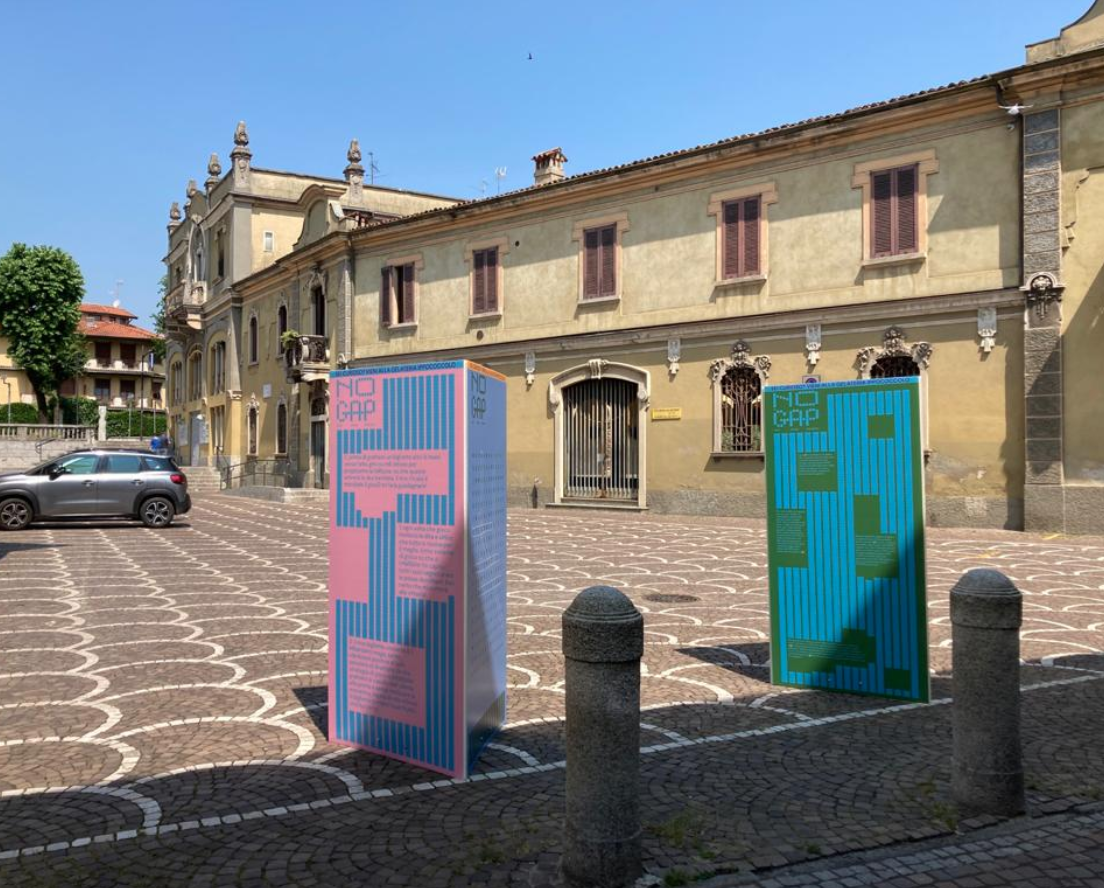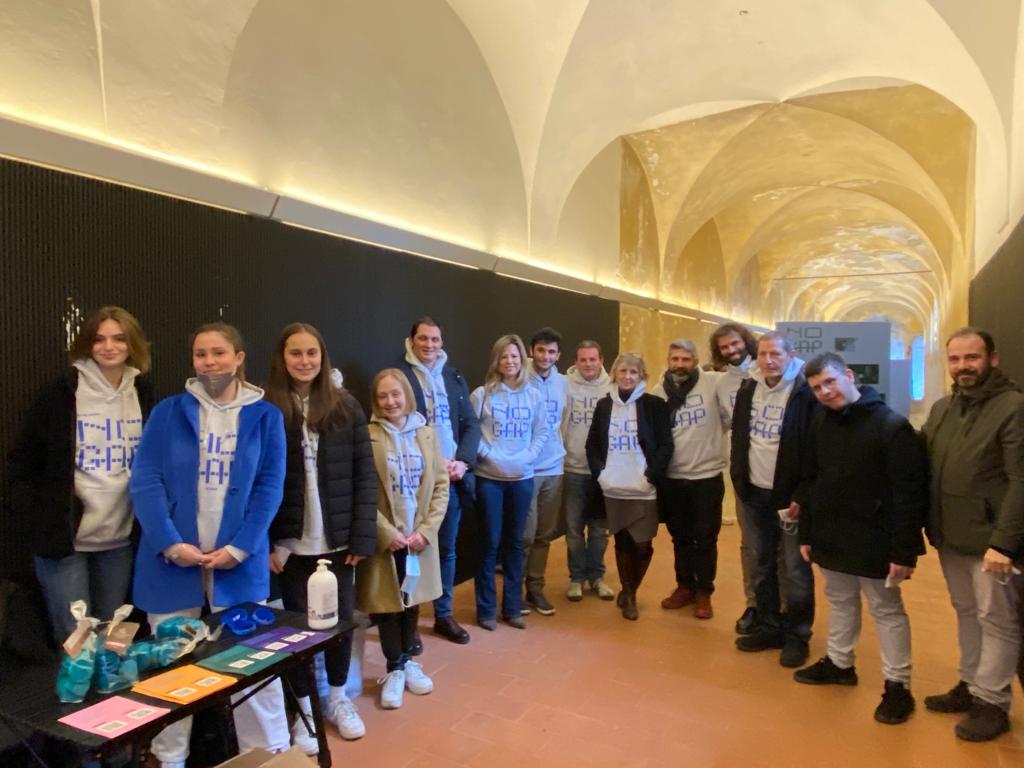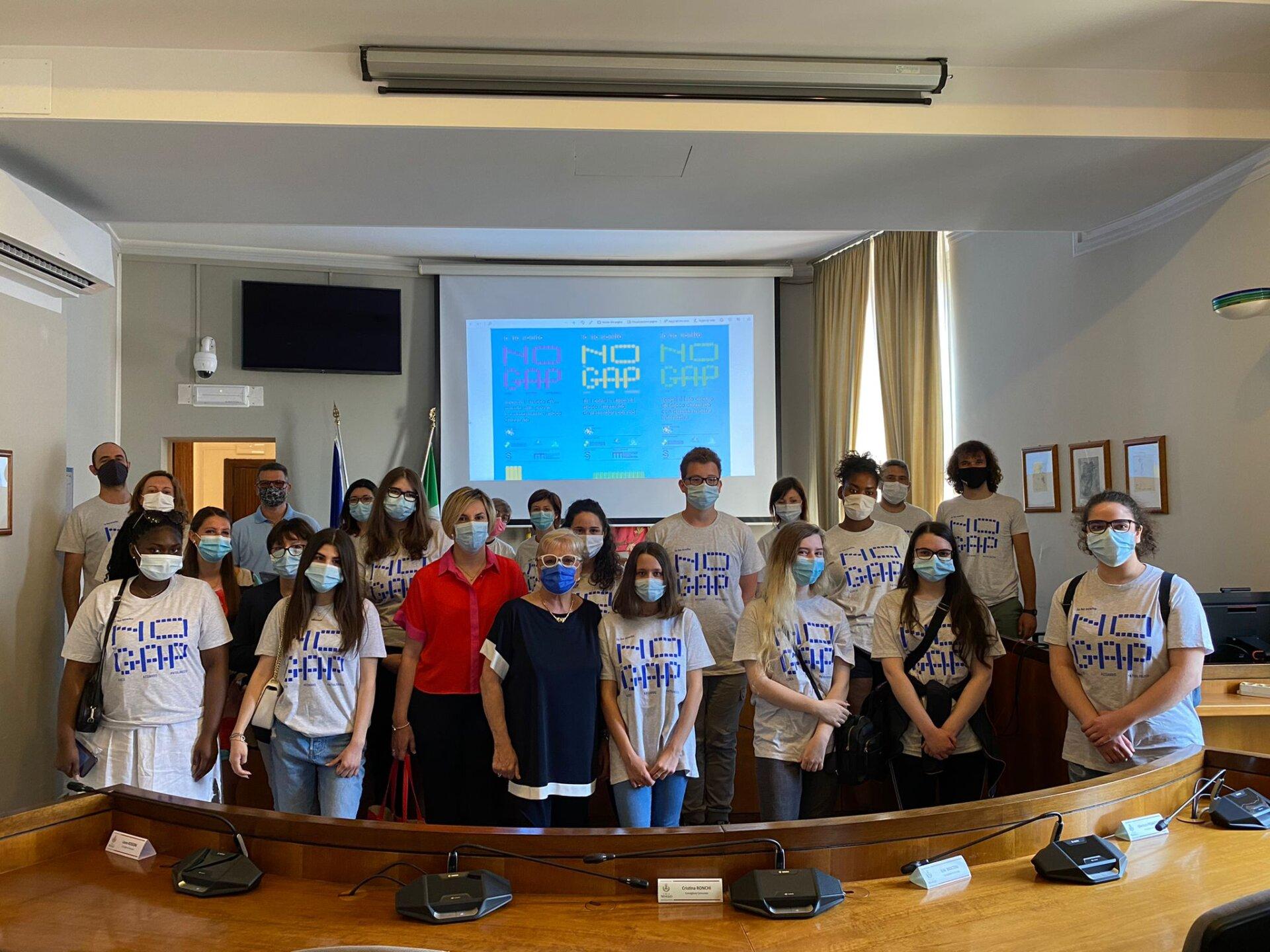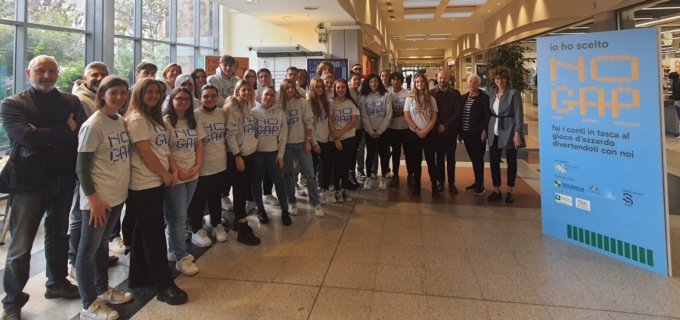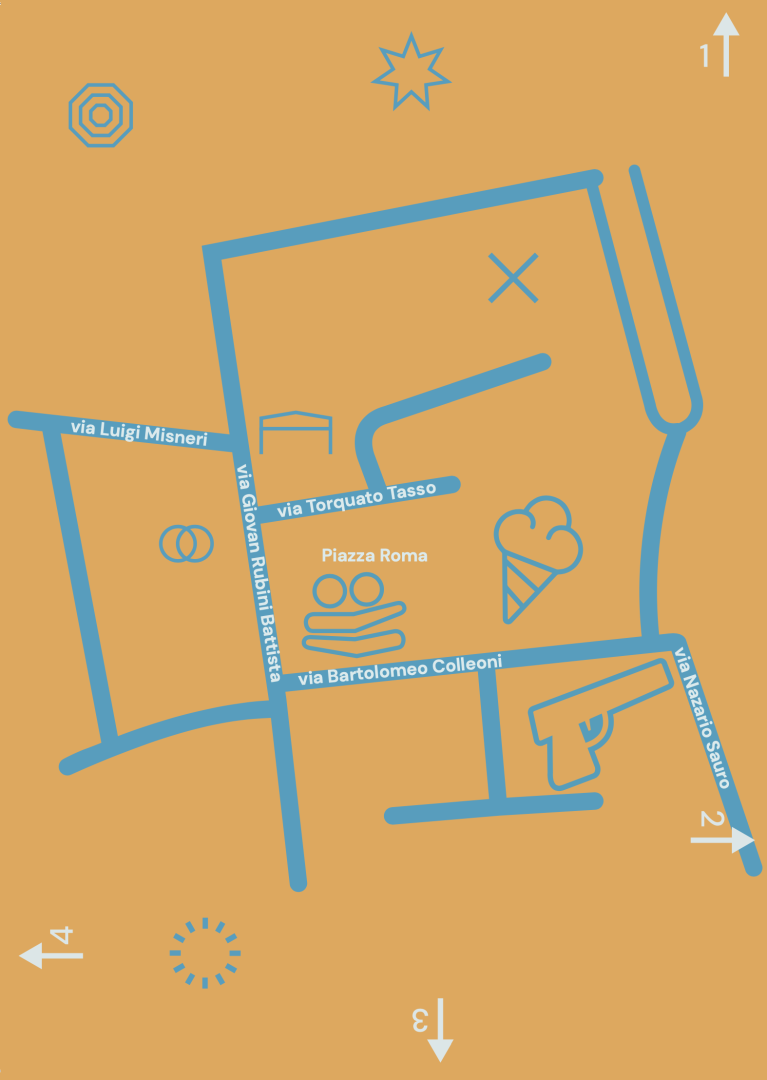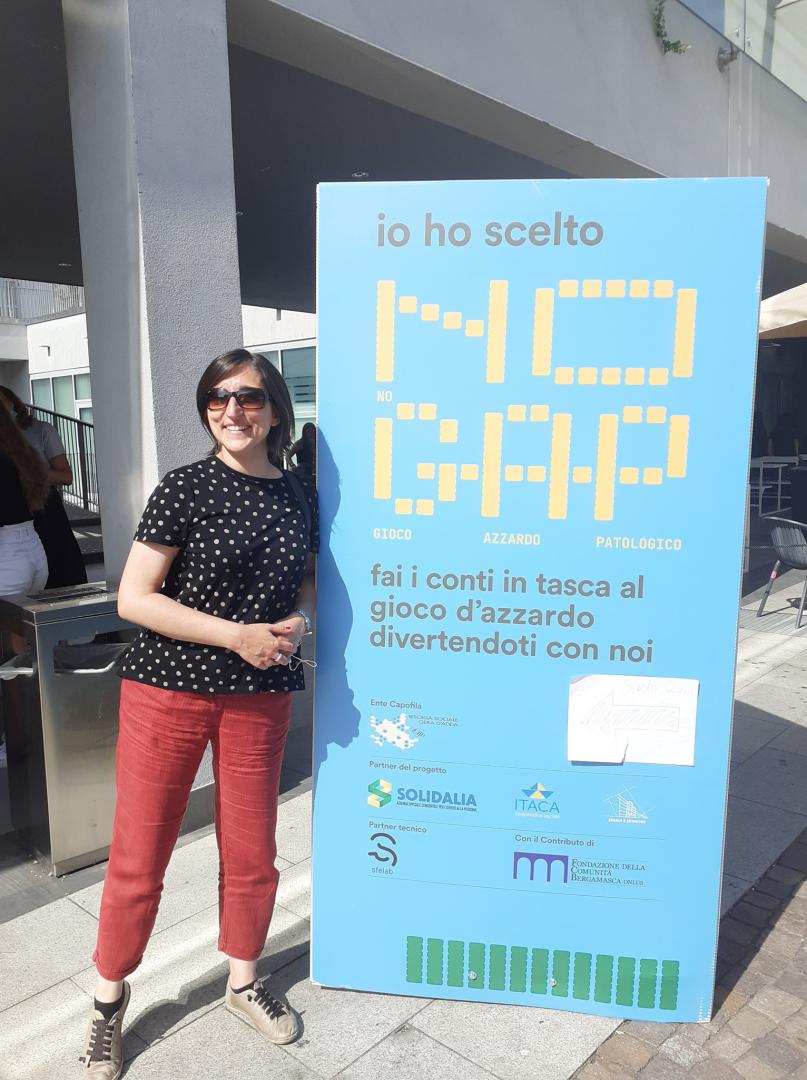NO-GAP
Basic information
Project Title
NO-GAP
Full project title
How to say NO to the GAP - Gioco d’Azzardo Patologico (pathological gambling)
Category
Regaining a sense of belonging
Project Description
NO-GAP is a game exhibition created with the goal of transmitting awareness-raising content about pathological gambling through playful and interactive methods, with the final aim of prevention. It is based on the concept of 'gamification': we use elements taken from the gaming experience itself and apply them in non-gamified contexts to convey a message. The concept, already known in Europe, is not so widespread in Italy, making the NO-GAP exhibition an absolute novelty on the local scene.
Geographical Scope
Local
Project Region
Romano di Lombardia, Treviglio, Bergamo, Italy
Urban or rural issues
Mainly urban
Physical or other transformations
It refers to other types of transformations (soft investment)
EU Programme or fund
No
Description of the project
Summary
The NO-GAP interactive game exhibition pursued the objective of transmitting awareness-raising content regarding gambling and pathological gambling through playful and interactive methods. The prevention of pathological gambling has been rooted in the protagonism of adolescents, the involvement of the community, and the use of tools bridging the virtual and real worlds.
The project was developed around a twofold idea:
1\ The creation of a link between schools and local communities in terms of prevention actions, for the co-construction of a community's vision and heritage. The intent was to overcome the traditional logic of preventive intervention in the school context, which, while effective, isolates the adolescent's experience. Instead, the project sought new "times and spaces" capable of engaging a broader audience, including adults in the community. This also involved initial discussions with adolescents themselves about the topics of addiction and gambling.
2\ The experimentation of a method that combines peer education with design fields and tools (e.g., the practice of gamification and co-design tools used to explore game design concepts). Through peer learning sessions, students assimilate information more effectively than in individual learning contexts and simultaneously strengthen their interaction skills within the group. For the development of the design solution, our interactive game exhibition, we conducted co-design sessions at school, assisting peer groups in step-by-step game design in "non-playful environments" (in our case, an outdoor Escape room experience on an urban scale).
ITACA onlus has been the main promoter of the project, with the involvement of Studio Shift and Sfelab as technical partners. The process began in 2020 and used the restrictions implemented for pandemic prevention as an opportunity to review and innovate the intervention format, which took place in hybrid modalities.
The project was developed around a twofold idea:
1\ The creation of a link between schools and local communities in terms of prevention actions, for the co-construction of a community's vision and heritage. The intent was to overcome the traditional logic of preventive intervention in the school context, which, while effective, isolates the adolescent's experience. Instead, the project sought new "times and spaces" capable of engaging a broader audience, including adults in the community. This also involved initial discussions with adolescents themselves about the topics of addiction and gambling.
2\ The experimentation of a method that combines peer education with design fields and tools (e.g., the practice of gamification and co-design tools used to explore game design concepts). Through peer learning sessions, students assimilate information more effectively than in individual learning contexts and simultaneously strengthen their interaction skills within the group. For the development of the design solution, our interactive game exhibition, we conducted co-design sessions at school, assisting peer groups in step-by-step game design in "non-playful environments" (in our case, an outdoor Escape room experience on an urban scale).
ITACA onlus has been the main promoter of the project, with the involvement of Studio Shift and Sfelab as technical partners. The process began in 2020 and used the restrictions implemented for pandemic prevention as an opportunity to review and innovate the intervention format, which took place in hybrid modalities.
Key objectives for sustainability
The sustainability of meaning - the concept of the project was built with a strong networking action, initially between the proponents and later in dialogue with the context, which involved schools, local public administrations (in the places where the exhibition game actually took place), and 'neighborhood' commercial actors.
Environmental sustainability - the idea of the project was conceived and implemented during the Covid-19 pandemic. Consequently, there was a need to transpose all the usual practices (both peer-to-peer education and co-design) into a digital environment. Once the initial critical issues were overcome, which were also connected to the rapid digital reorganization required by the schools themselves, it is worth highlighting the 'pros' that this adaptation has created, especially in terms of savings in consumption and travel costs for conductors and tutors. This made the sessions more accessible to all participants. The digital management of processes also allowed all participants, including students who are generally more shy and reserved in group situations in person, to participate in a protected way in all appointments, subjectively measuring their visibility and engagement.
With an eye also to practical achievements, concerning the environmental theme, the choice to use the city and its open spaces as the main location stands out. This involves seizing the double potential of outdoor places (therefore safer for the post-pandemic period) and small walking itineraries to promote gentle mobility and neighborhood exploration.
Last but not least, economic sustainability - the project was supported by the consortium company Risorsa Sociale Gera d'Adda in the Treviglio area and by the Solidalia consortium company in the Romano di Lombardia area, thanks to funding from the Bergamo Community Foundation.
Environmental sustainability - the idea of the project was conceived and implemented during the Covid-19 pandemic. Consequently, there was a need to transpose all the usual practices (both peer-to-peer education and co-design) into a digital environment. Once the initial critical issues were overcome, which were also connected to the rapid digital reorganization required by the schools themselves, it is worth highlighting the 'pros' that this adaptation has created, especially in terms of savings in consumption and travel costs for conductors and tutors. This made the sessions more accessible to all participants. The digital management of processes also allowed all participants, including students who are generally more shy and reserved in group situations in person, to participate in a protected way in all appointments, subjectively measuring their visibility and engagement.
With an eye also to practical achievements, concerning the environmental theme, the choice to use the city and its open spaces as the main location stands out. This involves seizing the double potential of outdoor places (therefore safer for the post-pandemic period) and small walking itineraries to promote gentle mobility and neighborhood exploration.
Last but not least, economic sustainability - the project was supported by the consortium company Risorsa Sociale Gera d'Adda in the Treviglio area and by the Solidalia consortium company in the Romano di Lombardia area, thanks to funding from the Bergamo Community Foundation.
Key objectives for aesthetics and quality
The theme of aesthetics in the project was conceived as a cultural affordance of languages (and, consequently, visual solutions) used to reach the main beneficiaries of the project—adolescents in the 14/18-year-old target range. For this reason, the multimedia interactive path for the NO-GAP game-exhibition was built on the concept of "gamification." The idea drew inspiration from escape rooms and treasure hunts, where participants must employ logic, intuition, knowledge of environments, and other personal skills to progress in the game and utilize the knowledge they gradually acquire along the paths. This concept, already known in Europe, is not widespread in Italy, making the NO-GAP game-exhibition an absolute novelty on our national scene.
The multimedia contents were designed to be familiar to young audiences: short-lived, bidirectional in the continuous search for users' feedback, stories told in the first person, combining known historical events with personal ones. These stories were adapted (in terms of content, style, and tone of voice) to multiple categories of visitors (teens, young people, adults, and seniors) based on the targets highlighted by local data on the phenomenon of pathological gambling. These are the ingredients we used to deeply engage the visitor and leave a lasting mark.
For the final aesthetic development of the project, the interaction design studio Sfelab (Cantu, Italy) was involved. They professionally produced and finalized the contents co-created with high school students in the co-design sessions conducted by SHIFT and ITACA.
The multimedia contents were designed to be familiar to young audiences: short-lived, bidirectional in the continuous search for users' feedback, stories told in the first person, combining known historical events with personal ones. These stories were adapted (in terms of content, style, and tone of voice) to multiple categories of visitors (teens, young people, adults, and seniors) based on the targets highlighted by local data on the phenomenon of pathological gambling. These are the ingredients we used to deeply engage the visitor and leave a lasting mark.
For the final aesthetic development of the project, the interaction design studio Sfelab (Cantu, Italy) was involved. They professionally produced and finalized the contents co-created with high school students in the co-design sessions conducted by SHIFT and ITACA.
Key objectives for inclusion
The game-exhibition aims to raise awareness among the population about the issue of gambling, employing a different and engaging methodology. With this perspective, we collaborated with local high schools, co-planning the experience—also from an educational point of view—in conjunction with the teachers and integrating it into the School-Work Program offer.
The participating schools included higher institutes such as ISS Zenale and Butinone in Treviglio, Istituto Superiore Don Lorenzo Milani in Romano di Lombardia, and the classical high school Sarpi in Bergamo City.
The main engagement activities targeted youngsters, fostering their active involvement not only in developing the narrative contents of the game (including suggestions for desirable User Experience) but also in designing solutions such as game steps and User Interface ideas for the mobile application. This approach contributed to a transformation of traditional teacher/learner roles. The work was carried out with a focus on developing an 'educational community' in addition to youth protagonism. The young people became experts in the project's objective and the topic/problem of gambling. With the support of external technicians (SHIFT, ITACA, and subsequently Sfelab), they also competently discussed processes and solutions.
At the end of the process, teachers and parents became users of the NOGAP exhibition-game, thereby becoming primary beneficiaries of the teaching experience. In some cases, they also became secondary beneficiaries of the cultural experience itself (the app).
The participating schools included higher institutes such as ISS Zenale and Butinone in Treviglio, Istituto Superiore Don Lorenzo Milani in Romano di Lombardia, and the classical high school Sarpi in Bergamo City.
The main engagement activities targeted youngsters, fostering their active involvement not only in developing the narrative contents of the game (including suggestions for desirable User Experience) but also in designing solutions such as game steps and User Interface ideas for the mobile application. This approach contributed to a transformation of traditional teacher/learner roles. The work was carried out with a focus on developing an 'educational community' in addition to youth protagonism. The young people became experts in the project's objective and the topic/problem of gambling. With the support of external technicians (SHIFT, ITACA, and subsequently Sfelab), they also competently discussed processes and solutions.
At the end of the process, teachers and parents became users of the NOGAP exhibition-game, thereby becoming primary beneficiaries of the teaching experience. In some cases, they also became secondary beneficiaries of the cultural experience itself (the app).
Results in relation to category
The NO-GAP exhibition-game (2020-21) achieved the following results:
1 brand for the project and related graphic artifacts
2 outdoor editions of the game, including 6 different draws with content/stories dedicated to children, adults, and OVER65s
1 digital application for interactions
1 analog city map
A series of totems to be used in public spaces as touchpoints, in dialogue with the mobile app
A communication kit for commercial operators on a neighborhood scale to promote the initiative
Great resonance in the local newspaper and on social channels
The path with a "young" or an "adult" as a character was enabled by the use of the map plus an easily downloadable application. Through this app, video content was conveyed, and participants had to solve questions to pass the following levels and address the escape room dilemma. The "OVER65s" itineraries, on the other hand, required the use of the paper map only and the viewing of short videos at the information point.
In 2022, a second edition of the project was tested and implemented with the title of NO-GAP School-Exhibition. Emphasizing community empowerment and youth protagonism, the peer educators from the high schools who participated in the previous project were once again involved. Senior students were tasked with proposing and managing the new activity within their classes.
The game drew inspiration from the contents of Marco Baldini's autobiographical book, "The Player," with a specific focus on mathematical concepts connected to the 'fixed loss' and other characteristics that make a game more dangerous. Participants were invited to identify with 5 different characters (the father, the sister, the girlfriend, the friend, the teacher) who aimed to help the protagonist/player overcome addiction.
There were 50 peers involved; they made it possible to reach 30 classes for a total of about 750 students.
1 brand for the project and related graphic artifacts
2 outdoor editions of the game, including 6 different draws with content/stories dedicated to children, adults, and OVER65s
1 digital application for interactions
1 analog city map
A series of totems to be used in public spaces as touchpoints, in dialogue with the mobile app
A communication kit for commercial operators on a neighborhood scale to promote the initiative
Great resonance in the local newspaper and on social channels
The path with a "young" or an "adult" as a character was enabled by the use of the map plus an easily downloadable application. Through this app, video content was conveyed, and participants had to solve questions to pass the following levels and address the escape room dilemma. The "OVER65s" itineraries, on the other hand, required the use of the paper map only and the viewing of short videos at the information point.
In 2022, a second edition of the project was tested and implemented with the title of NO-GAP School-Exhibition. Emphasizing community empowerment and youth protagonism, the peer educators from the high schools who participated in the previous project were once again involved. Senior students were tasked with proposing and managing the new activity within their classes.
The game drew inspiration from the contents of Marco Baldini's autobiographical book, "The Player," with a specific focus on mathematical concepts connected to the 'fixed loss' and other characteristics that make a game more dangerous. Participants were invited to identify with 5 different characters (the father, the sister, the girlfriend, the friend, the teacher) who aimed to help the protagonist/player overcome addiction.
There were 50 peers involved; they made it possible to reach 30 classes for a total of about 750 students.
How Citizens benefit
The NO-GAP project aims to address the issue of preventing pathological gambling at the community and city scale. Particularly, through engagement with young people and using popular practices (e.g., escape rooms) and virtual devices as solution supports, we have made the experience highly relatable to the desired target users.
Based on these principles, the process was accompanied by constant dialogue among the school, Territorial Areas (Public administration), and various actors in local communities—such as the parish priest, the mayor, town merchants, and volunteers. This dialogue aimed to agree on the urban spaces to be utilized, the logistics and period of implementation, the involvement and encouragement of merchants to participate in the game, and the recruitment of volunteers to oversee and promote NO-GAP.
After three different experiences, held during the summer in three locations (Municipalities of Treviglio, Romano di Lombardia, and Bergamo City), a total of 2000 participants were registered using the mobile application.
Based on these principles, the process was accompanied by constant dialogue among the school, Territorial Areas (Public administration), and various actors in local communities—such as the parish priest, the mayor, town merchants, and volunteers. This dialogue aimed to agree on the urban spaces to be utilized, the logistics and period of implementation, the involvement and encouragement of merchants to participate in the game, and the recruitment of volunteers to oversee and promote NO-GAP.
After three different experiences, held during the summer in three locations (Municipalities of Treviglio, Romano di Lombardia, and Bergamo City), a total of 2000 participants were registered using the mobile application.
Physical or other transformations
It refers to other types of transformations (soft investment)
Innovative character
The intention at the heart of the choice to use the 'experience of the game' in a positive way was to counter the opposite experience of addiction. This was the meta-message: we wanted to prove and allow users to experience that with the game, you can also grow and change, seeing the world with a different perspective.
The multimedia interactive installations offer the possibility to involve not only young people but also families and teachers, making them feel an active part of the communication process that includes a wide variety of final targets. Multimedia has made it possible to engage the visitor proactively, helping to solidify concepts, sensations, and discoveries in their mind and memory, and even in their physical experience (whether navigating the city alone or in groups).
The multimedia interactive installations offer the possibility to involve not only young people but also families and teachers, making them feel an active part of the communication process that includes a wide variety of final targets. Multimedia has made it possible to engage the visitor proactively, helping to solidify concepts, sensations, and discoveries in their mind and memory, and even in their physical experience (whether navigating the city alone or in groups).
Disciplines/knowledge reflected
Health promotion and addiction prevention activities are conducted through projects jointly promoted and supported by the Lombardy Region and the Regional School Office. Their methodological approach includes strategies for health promotion and addiction prevention, the promotion of educational strategies for the development of life skills, as provided by the Health Promoting School program and the network of health-promoting schools, and the implementation of interventions subjected to the evaluation of effectiveness.
The theoretical premise of the intervention is the community development approach integrated with peer education methodologies, based on scientific evidence. It addresses all the most important individual and social factors that lead adolescents to adopt risky behaviors, using effective methods for the promotion of transversal skills and competences. It provides students with elements of knowledge, subsidies, and tools useful for managing group situations and those at risk.
The Peer education approach is an intervention fully recognized in scientific literature as an effective preventive methodology. In the NO-GAP game-exhibition project, this approach intersects with design domains, particularly co-creation (both co-design and co-production) and interaction design.
The Peer education approach originated in the 60s in the USA and values learning within a group of peers or people belonging to the same status. Design, with its natural learning-by-doing approach, has provided the enabling settings and practical tools to support collaborative activations and facilitate groups during design sessions and decision-making processes. Brainstorming techniques, user stories, personas profiles, and storyboards are just a few examples of design tools we used. Ice-breaking exercises, observation of social dynamics, and the care for the emotional impact within the group have been nurtured by educators and teachers.
The theoretical premise of the intervention is the community development approach integrated with peer education methodologies, based on scientific evidence. It addresses all the most important individual and social factors that lead adolescents to adopt risky behaviors, using effective methods for the promotion of transversal skills and competences. It provides students with elements of knowledge, subsidies, and tools useful for managing group situations and those at risk.
The Peer education approach is an intervention fully recognized in scientific literature as an effective preventive methodology. In the NO-GAP game-exhibition project, this approach intersects with design domains, particularly co-creation (both co-design and co-production) and interaction design.
The Peer education approach originated in the 60s in the USA and values learning within a group of peers or people belonging to the same status. Design, with its natural learning-by-doing approach, has provided the enabling settings and practical tools to support collaborative activations and facilitate groups during design sessions and decision-making processes. Brainstorming techniques, user stories, personas profiles, and storyboards are just a few examples of design tools we used. Ice-breaking exercises, observation of social dynamics, and the care for the emotional impact within the group have been nurtured by educators and teachers.
Methodology used
1. THE ACTIVATION OF LOCAL NETWORK AND CONSENSUS:
The initial concept of the game-exhibition was defined by the operators of the ITACA Cooperative in collaboration with Studio SHIFT, and the contents were shared with ATS Bergamo. An active listening dialogue was opened for all territorial stakeholders.
2. THE PROCESS OF CO-CREATION:
The NO-GAP process was presented to local high schools, invited to attend an ad-hoc training session about gambling led by ITACA. From the theme to the concept, Studio SHIFT planned and led online sessions with students to introduce gamification rules and experiment with design tools, allowing the elaboration of creative proposals. At the end of these meetings, the students were divided into small groups and asked to elaborate a first "project sheet," a draft idea canvas that included objectives, recipients, actions, duration, and the general purpose of their potential game-exhibition. It also included hypothetical targets, such as the representation of a character standing for a specific age group (personas profile) to which the gaming experience would be addressed.
3. THE PROFESSIONAL FINALIZATION OF OUTPUT:
From concept to product, the students embarked on a new journey (including technical tips) with Sfelab to implement selected proposals from the wider range of collected ideas. The students created a more detailed story-script, defining the stories, game dynamics, and mechanics (always considering the escape room format), such as the type of puzzles to be solved, duration, and where interactive touchpoints should be installed. They also dealt entirely with the creation of the videos to be included in the paths, from dialogues to construction. Additionally, Sfelab took care of creating graphics and the app to be used during the game up to executive files and production.
Simultaneously, local community actors, including the parish priest, the mayor, town merchants, and volunteers, were involved.
The initial concept of the game-exhibition was defined by the operators of the ITACA Cooperative in collaboration with Studio SHIFT, and the contents were shared with ATS Bergamo. An active listening dialogue was opened for all territorial stakeholders.
2. THE PROCESS OF CO-CREATION:
The NO-GAP process was presented to local high schools, invited to attend an ad-hoc training session about gambling led by ITACA. From the theme to the concept, Studio SHIFT planned and led online sessions with students to introduce gamification rules and experiment with design tools, allowing the elaboration of creative proposals. At the end of these meetings, the students were divided into small groups and asked to elaborate a first "project sheet," a draft idea canvas that included objectives, recipients, actions, duration, and the general purpose of their potential game-exhibition. It also included hypothetical targets, such as the representation of a character standing for a specific age group (personas profile) to which the gaming experience would be addressed.
3. THE PROFESSIONAL FINALIZATION OF OUTPUT:
From concept to product, the students embarked on a new journey (including technical tips) with Sfelab to implement selected proposals from the wider range of collected ideas. The students created a more detailed story-script, defining the stories, game dynamics, and mechanics (always considering the escape room format), such as the type of puzzles to be solved, duration, and where interactive touchpoints should be installed. They also dealt entirely with the creation of the videos to be included in the paths, from dialogues to construction. Additionally, Sfelab took care of creating graphics and the app to be used during the game up to executive files and production.
Simultaneously, local community actors, including the parish priest, the mayor, town merchants, and volunteers, were involved.
How stakeholders are engaged
Pathological gambling is a phenomenon that has garnered increased attention from the Lombardy Region. Through regional law 8/2013, the region has promoted and supported actions aimed at preventing and countering forms of addiction, as well as treating and facilitating the recovery of individuals affected by it.
For some years now, Lombardy territories have been able to benefit from these resources to structure and plan processes strongly oriented towards the appropriateness of interventions, the integration and inter-sector nature of preventive actions, and the development of local governance actions involving plural governance. The NO-GAP game-exhibition serves as a good example, based on the synergy of all actors in the social and socio-health system. Local authorities, the third sector, businesses, and trade associations were horizontally engaged in the concept and thinking phase, or in the co-production of the initiative.
Under the supervision of ATS Bergamo (a local public body managing policies and services to address people's needs), the ITACA Cooperative acted as an interpreter and promoter of the project. As outlined, the project involved designers from Studio Shift, co-design experts, and engineers from Sfelab, who specialize in interaction and visual design. These technical partners actively contributed to the planning and implementation of the process (the former) and the finalization of the product (the latter), supporting the initiative throughout the implementation period. The ITACA Cooperative provided indispensable educational support, with a specific focus on life skills and the peer-to-peer education approach, as well as a network of territorial relationships essential for generating consensus for the NO-GAP project.
For some years now, Lombardy territories have been able to benefit from these resources to structure and plan processes strongly oriented towards the appropriateness of interventions, the integration and inter-sector nature of preventive actions, and the development of local governance actions involving plural governance. The NO-GAP game-exhibition serves as a good example, based on the synergy of all actors in the social and socio-health system. Local authorities, the third sector, businesses, and trade associations were horizontally engaged in the concept and thinking phase, or in the co-production of the initiative.
Under the supervision of ATS Bergamo (a local public body managing policies and services to address people's needs), the ITACA Cooperative acted as an interpreter and promoter of the project. As outlined, the project involved designers from Studio Shift, co-design experts, and engineers from Sfelab, who specialize in interaction and visual design. These technical partners actively contributed to the planning and implementation of the process (the former) and the finalization of the product (the latter), supporting the initiative throughout the implementation period. The ITACA Cooperative provided indispensable educational support, with a specific focus on life skills and the peer-to-peer education approach, as well as a network of territorial relationships essential for generating consensus for the NO-GAP project.
Global challenges
In 2021, the volume of money played in Italy increased by 21%, reaching a value of 111.17 billion euros, influenced in part by the closures imposed on physical gaming during the Covid-19 pandemic. Over the last twelve months, 5% of young people played at least once a week or every day (frequent players), while another 5% did so on a monthly basis. Online gaming now prevails for 1 in 3 players (31%), with online sports betting taking the lead at 42% (followed by online poker at 24% and online casinos at 21%). Among young people, the most popular game is Scratch & Win, preferred by 56%, followed by sports betting in agencies at 22%.
For 88% of players under 19, the average weekly expenditure for games is less than 5 euros. According to the Nomisma study, 9% of players have developed problematic gambling habits in the last year, exhibiting symptoms capable of generating negative effects on the psycho-emotional sphere (anxiety, agitation, loss of control) and affecting relationships (family, friends, school). Additionally, 11% of young people who have played in the last 12 months are considered "at-risk players."
Pathological gambling is not limited to youngsters; in 2020, 25% of those over 65 played games at least once a month (16%). The Silver Age target mainly plays for fun or to distract from problems (35%) or for curiosity/pastime (29%). The over 65s prefer to play in physical places, such as tobacconists, bingo halls, bars, and betting agencies, with only 3% playing online (via computer, phone, or tablet). It is no coincidence that the NO-GAP experience has used the city and commercial establishments as principal touchpoints.
For 88% of players under 19, the average weekly expenditure for games is less than 5 euros. According to the Nomisma study, 9% of players have developed problematic gambling habits in the last year, exhibiting symptoms capable of generating negative effects on the psycho-emotional sphere (anxiety, agitation, loss of control) and affecting relationships (family, friends, school). Additionally, 11% of young people who have played in the last 12 months are considered "at-risk players."
Pathological gambling is not limited to youngsters; in 2020, 25% of those over 65 played games at least once a month (16%). The Silver Age target mainly plays for fun or to distract from problems (35%) or for curiosity/pastime (29%). The over 65s prefer to play in physical places, such as tobacconists, bingo halls, bars, and betting agencies, with only 3% playing online (via computer, phone, or tablet). It is no coincidence that the NO-GAP experience has used the city and commercial establishments as principal touchpoints.
Learning transferred to other parties
The NO-GAP game-exhibition process has been divided into three main phases, each with its distinct outputs:
Activation of the local network and consensus-building.
Co-creation involving co-design (learning sessions with students about the topic and co-design sessions at school) and co-production (action lab at school) activities.
Professional finalization of outputs, consisting of the digital game (mobile app) and related outdoor exhibition supports.
Reflecting on this process, we can assert that the format itself is highly transferable, especially in contexts where schools, the third sector, and design professionals—sensitive to the issues—are present, along with grassroots support. Naturally, the crucial support of local public bodies, responsible for approving public utility projects, should not be overlooked.
Considering the products, both digital (mobile app) and analog supports (e.g., graphic posters, flyers, maps to navigate the city, and outdoor totems to interact with digital contents) could be viewed as a practical conceptual 'tool-kit.' One can use this toolkit to produce materials at the end of a similar process, with the understanding that specific adaptations in terms of content and language may be necessary.
On the other side, locations, characters' stories guiding paths in the city (interacted with in the app), and specific statistics on the phenomenon of pathological gambling (appearing during interactions) are highly customizable.
Activation of the local network and consensus-building.
Co-creation involving co-design (learning sessions with students about the topic and co-design sessions at school) and co-production (action lab at school) activities.
Professional finalization of outputs, consisting of the digital game (mobile app) and related outdoor exhibition supports.
Reflecting on this process, we can assert that the format itself is highly transferable, especially in contexts where schools, the third sector, and design professionals—sensitive to the issues—are present, along with grassroots support. Naturally, the crucial support of local public bodies, responsible for approving public utility projects, should not be overlooked.
Considering the products, both digital (mobile app) and analog supports (e.g., graphic posters, flyers, maps to navigate the city, and outdoor totems to interact with digital contents) could be viewed as a practical conceptual 'tool-kit.' One can use this toolkit to produce materials at the end of a similar process, with the understanding that specific adaptations in terms of content and language may be necessary.
On the other side, locations, characters' stories guiding paths in the city (interacted with in the app), and specific statistics on the phenomenon of pathological gambling (appearing during interactions) are highly customizable.
Keywords
HIGH SCHOOL ENGAGEMENT
CODESIGN
GAMBLING PREVENTION
YOUNGSTERS
URBAN PLACES

